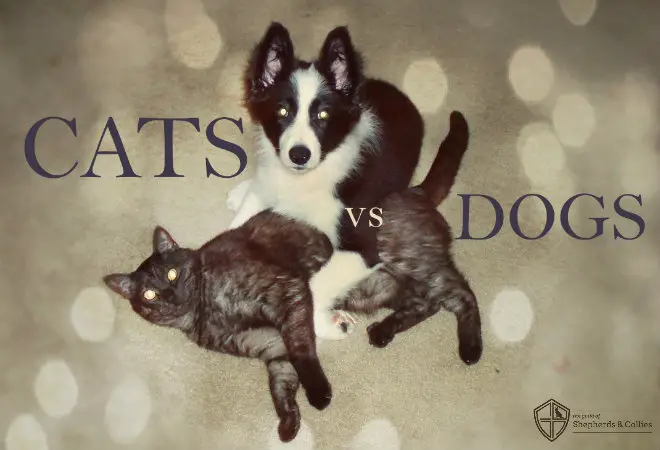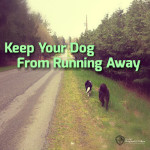4 Basic Steps for a Lifelong Bond: Canines and Felines
Dogs VS Cats: Creating a Lifelong Bond Doesn't Have to Be Difficult
This epic battle between two species has been going on for some time: the cat teases the dog, the dog chases the cat, and so forth. So how do you get the two to just “get along….”, creating a lifelong bond?
Instincts
Herding breeds are a special type of prey-driven dog, mainly due to the fact that they were bred to stalk and chase, but not to complete the fixed-action pattern (grabbing, shaking, and eating) like other breeds. This ultimately gives you the upper hand when introducing your herding breed to a cat, or another smaller animal, that could be mistaken for prey.
Don’t think I’m telling you to throw your dog in with a cat or smaller animal and expect it to NOT chomp on it, ultimately killing it. Remember that the herding instincts are there, but sometimes you need to fine tune them up to working order.
Both Sides Matter
When you’re introducing a dog and a cat, we can’t just think of the dog's comfort levels, we need to understand the cat’s comfort and attitude because ultimately, the cat can make things worse by reacting poorly to the situation, i.e. running and triggering prey drive. If we have a calm cat, the whole situation will be better and has a higher chance for success.
Puppies and Cats
Introducing your new puppy to a kitten is almost a guarantee for success, mainly because the cat has the upper hand when the dog is young and fearful. The cat hisses and swipes at the dog, the puppy runs away screaming bloody murder, and now that cat just realized the dog isn’t a threat and he has control over it (typical cat). Puppy realizes that cats are evil and to stay away. This can be a win-win for the remaining of the animals lives. Remember, the fear imprint period in puppies is 3-6 months - if something is mildly scary, they will remember that forever.
A good tip to remember when allowing a puppy to meet an adult cat is to trim the claws (a day or two prior to the meet), so the cat can’t accidentally scratch the puppies eye, causing damage.
Adult Dog and Kittens
Again, this can be quite successful with the main reason being that kittens don’t run, so it’s harder to trigger a prey response. There are still some dogs out there that have a high prey drive, which can be triggered by a smaller animal moving (at all), so you will still need to take precautions as outlined below.
Ultimately though, this is a very successful way to introduce the two species. We only need to concern ourselves with the dog being too rough with the fragile kitten. This is a time when it’s extra important to have good verbal control over your dog; to be able to keep her calm so she doesn’t accidentally crush the kitten with excitement.
This is a video of my Border Collie playing with our 9 week old kitten. Notice how much she is self-handicapping (suppressing the urge to go full out, knowing that she is playing with something small and fragile). Some dogs will naturally have this ability, whereas some dogs don’t.
Adult Dog and Adult Cat
This is definitely a tricky and careful interaction, especially if the dog has never seen a cat before and if the cat has never seen dogs before, or has only had bad encounters.
In this situation, there is really no room for error, especially if the dog is the same size (or larger) than the cat - this gives the dog the upper hand. Any contact that isn’t positive can seriously harm the cat, both physically and psychologically. Remember that we need to think of both the dog’s and cat’s welfare during these introductions.
Here are 4 Steps to Introducing a Dog to a Cat
Step 1 – Keep the two animals behind a door or baby gate that cannot be knocked down, so they can get the scent of one another.
Step 2 – When the dog smells the cat’s scent, you should see some excitement or arousal, and at that very second you need to control the dog’s excitement with a “leave it” command. If the dog complies, then praise and reward with calm behaviour. We DO NOT want to amp the dog up at all with play or rough games. Just a calm pet, with calm praise should do nicely.
Step 3 – After a day, start introducing the cat into the living space with the dog ON LEASH and as far away as possible. Try giving the cat a cat post that is very high so she feels safe, even allowing the cat on the counters or other high areas where she can feel secure while the dog is around. Try feeding the cat her favourite treats, catnip, or soft canned food while the dog is around.
Step 4 – While the cat is eating or hanging out, work with your dog to habituate with the cat. Focus on obedience cues, and “leave it’s” if the dog starts paying too much attention to the cat. Note: some attention is good, long attention is bad.
These introductions need to be done multiple times per day for weeks, even months before they can be trusted around one another, and you must always keep in the back of your head that this may not work out. If you feel one of the animals’ welfare is in danger, you must make the appropriate decision to protect that animal.
Article By:
Kris Crestejo, CDBC
Meet Our Evangelist








